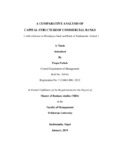Please use this identifier to cite or link to this item:
https://elibrary.tucl.edu.np/handle/123456789/1116| Title: | A Comparative Analysis of Capital Structure of Commercial Banks ( With Reference to Himalayan Bank and Bank of Kathmandu Limited ) |
| Authors: | Pathak, Puspa |
| Keywords: | Comparative analysis |
| Issue Date: | 2019 |
| Publisher: | Central Department of Management |
| Abstract: | Capital Structure is the composition of debt and equity that comprise a firm’s financing of its assets. Capital structure plays vital role to increase the profitability, to ensure the minimum cost of capital and the maximum return to equity holder. The financial soundness and strengths of a bank depend to a large extent on the composition of capital and assets. The Purpose of the study was to compare the capital structure of Commercial Banks of Nepal. Himalayan Bank and Bank of Kathmandu LTDwere taken as sample on convenience sampling basis. The annual reports were used for this study which covers a period of 5yrs from 2013 to 2017. The Findings showed that Nepalese Commercial banks do not have appropriate ratio of long term debt and have not used it properly. Banks have used low debt so as to pay lesser amount as interest on debt. The interest coverage ratio shows that banks are able to cover the interest but have not maintained higher interest coverage ratio. Return on assets and return on shareholder’s equity has fluctuating trend. Banks have the problem of instable return. The use of debt and equity has fluctuated over the years and return on shareholder’s equity has not been satisfactory in commercial banks of Nepal. Shareholders have not gained considerate amount in earnings from investment in shares. Banks have used low debt so as to pay lesser amount as interest on debt. An optimal capital structure would fulfill the interest of equity shareholder and financing requirement of a company as well as other concerned groups. The study concludes that with the increased use of leverage, overall cost of capital declines and the total value of the firm rise. The firm with the highest value and the least cost of capitalization rate is considered to have the best capital structure. Similarly change in the leverage do not lead to change in the total value of the firm and market price of the share, as the overall cost of capital is independent of the degree of leverage. The commercial banks have to take corrective actions to decrease the risk. |
| URI: | http://elibrary.tucl.edu.np/handle/123456789/1116 |
| Appears in Collections: | Finance |
Files in This Item:
| File | Description | Size | Format | |
|---|---|---|---|---|
| Puspa Pathak.pdf | 1.01 MB | Adobe PDF |  View/Open |
Items in DSpace are protected by copyright, with all rights reserved, unless otherwise indicated.
